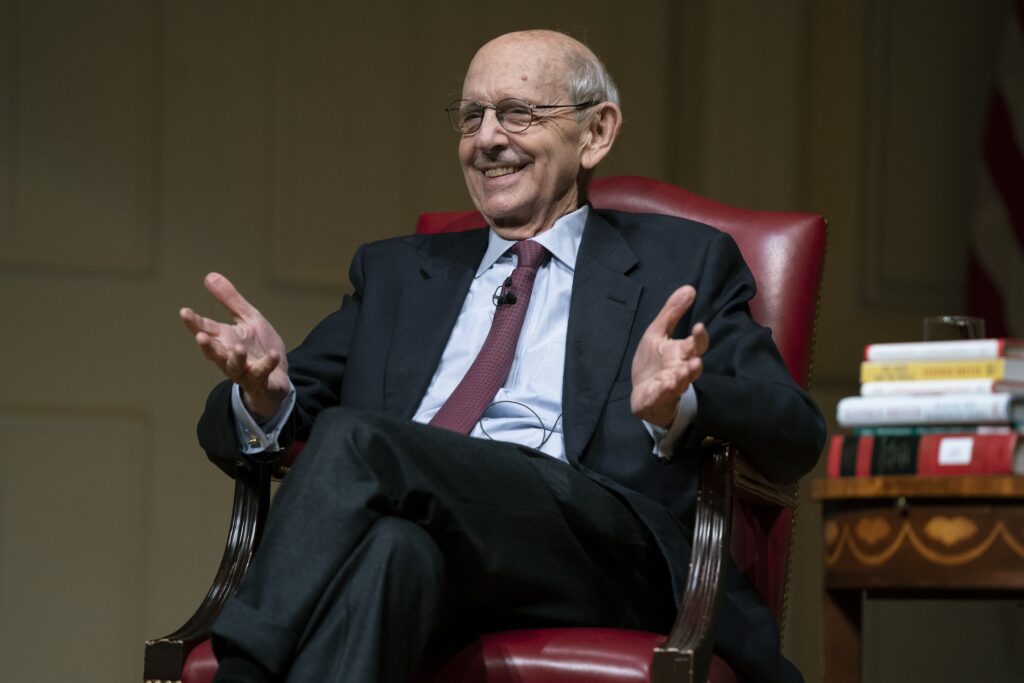
Retired Justice Stephen Breyer believes the Supreme Court decision to overturn Roe v. Wade two years ago marked a “deeply regressive feature” of the approach to law taken by the high court’s Republican-appointed majority, according to his new book.
Breyer, 85, was an appointee of former President Bill Clinton who retired in 2022, just days after the pivotal Dobbs v. Jackson Women’s Health Organization decision that held states can enact their own laws restricting or limiting abortion access, a 6-3 ruling led by the Republican-appointed majority.
The justice’s new book Why I Chose Pragmatism, Not Textualism laid out his argument critiquing the “originalism” jurisprudence often adhered to by Republican-appointed judges to interpret the Constitution.

“In Dobbs, the majority’s reasoning boiled down to one basic proposition: Because the people who ratified the original Constitution and the Fourteenth Amendment did not understand the document to protect reproductive rights, the document could not be read, now, as protecting those rights,” Breyer wrote, noting that the landmark abortion case “highlights a deeply regressive feature of the originalist approach.”
Textualism and originalism are considered methodologies for interpreting statutes and the Constitution by some justices on the court that were spearheaded by jurists such as the late Justice Antonin Scalia and other Republican-appointed legal figures such as Edwin Meese and Robert Bork. Textualism typically demands a strict interpretation of the language of the Constitution, while originalism commands adherence to history.
Breyer, who was described as the high court’s pragmatic justice during his 28-year stint on the bench, has a jurisprudence that considers the practical consequences when deciding cases, often focusing on the real-life effects on the people who feel the impact of the court’s decision.
The retired justice noted that his dissent from the Dobbs majority, joined by Democratic-appointed Justices Elena Kagan and Sonia Sotomayor, “pointed out that ‘people’ did not ratify the original Constitution in 1788 or the Fourteenth Amendment in 1868.”
“White men did,” Breyer wrote, adding that “women were not understood as full members of the political community at either of these points in history.”
Breyer wrote in the “face of this progress” from women gaining the right to vote in 1920 to the “right to an abortion” following the 1973 Roe v. Wade decision, “originalism would limit the kinds of liberty interest cognizable under the Fourteenth Amendment to those contemplated by men who existed in a time when women were not considered to have a legal identity separate from their husbands.”
“And so, by saying that ‘we must read our foundational charter as viewed at the time of ratification,” the majority ‘cosign[ed] women to second-class citizenship,’” Breyer said.
Breyer noted in his book that he does not consider the high court’s Republican-appointed justices as the ones strictly employing the originalist and textualist methods, writing that there is “evidence that we are in the midst of a paradigm shift that is moving in a textualist and originalist direction.” He cited writings from some Democratic-appointed justices in the minority who have emphasized statutory text and history to support their framework for handling cases.
However, the retired justice made clear that “it should become apparent that strict versions of textualism and originalism simply will not work” as the court moves ahead.
Federal judges adopted originalism and textualism as a broader jurisprudence during the 1980s in response to the notion of a “Living Constitution” that was commonly accepted throughout the earlier part of the 20th century. At the time, the Reagan-era Attorney General Edwin Meese was delivering speeches at the Federalist Society calling for a “jurisprudence based on first principles [that] is neither conservative nor liberal, neither right nor left,” but one that interprets the Constitution based on its original language.
While Breyer’s book is mostly focused on scholarly remarks about his time on the court rather than tidbits about his interactions with his eight former colleagues, the justices have taken a more candid approach to opining on his legacy during recent media interviews.
CLICK HERE TO READ MORE FROM THE WASHINGTON EXAMINER
Breyer told NBC News’s Meet the Press on Sunday he believes it is “possible” the Supreme Court could one day overrule the Dobbs, adding he “did not think” Roe or Planned Parenthood v. Casey should be overturned.
“But who knows?” Breyer said.





